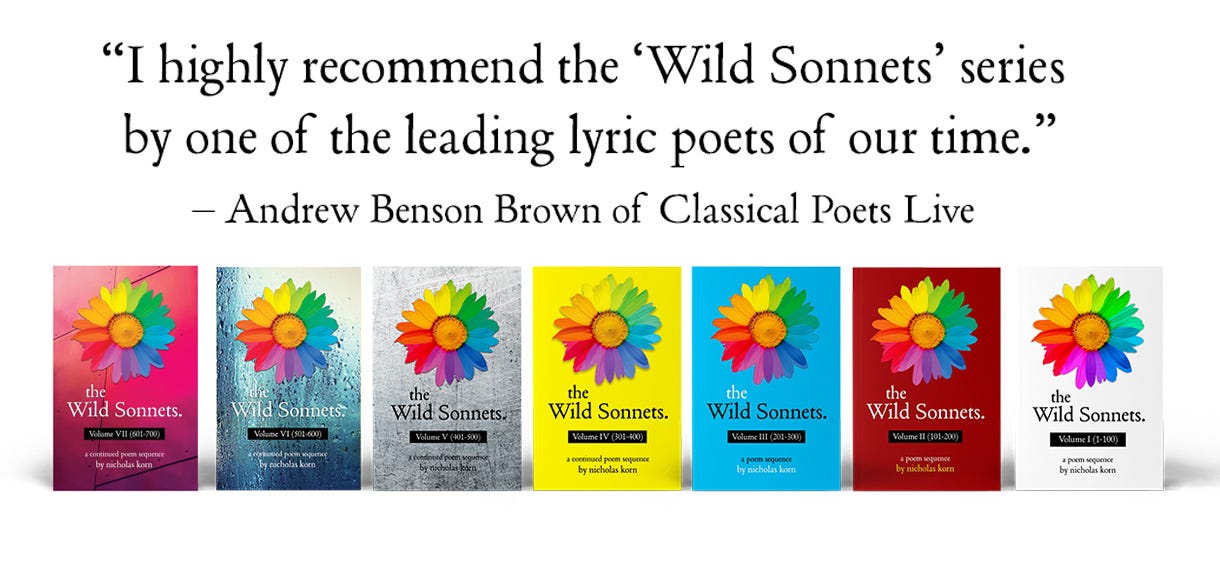A 10-Minute Poetry Class | The Wild Sonnets
A few thoughts and distinctions on writing and recognizing poetry
My personal thoughts for writers (and readers) on how to take their practice and understanding of poetry to the next level.
In this video, I discuss the following:
The Distinction Between What a Poem is and What Poetry Is
The Distinction Between Being a Poet of Message vs. a Poet of Experience
The Distinction Between Being a Poet of Witness vs. a Poet of Self
The two poems featured in this video were written by me specifically for this lesson.
Also, I welcome your comments on this material below. Thank you for reading, watching and listening.
Thanks for watching.
Stay Wild and Stay Well.
– Nicholas Korn, The Poet of the Wild Sonnets
THE MINI BOOKSTORE
Downloads | $7 each
The Wild Sonnets: Volume VII (601-700)
The Wild Sonnets: Volume VI (501-600)
The Wild Sonnets: Volume V (401-500)
The Wild Sonnets: Volume IV (301-400)
The Wild Sonnets: Volume III (201-300)
The Wild Sonnets: Volume II (101-200)
The Wild Sonnets: Volume I (1-100)
The Complete Download (All 7 Books for $25)
Paperback | $20 + S&H
Sold exclusively from BookBaby. These books look gorgeous.
The Wild Sonnets: Volume VII (601-700)
The Wild Sonnets: Volume VI (501-600)
The Wild Sonnets: Volume V (401-500)
The Wild Sonnets: Volume IV (301-400)
The Wild Sonnets: Volume III (201-300)
The Wild Sonnets: Volume II (101-200)
The Wild Sonnets: Volume VII (1-100)
ABOUT THE WILD SONNET FORM
The Wild Sonnet format follows the traditional length of fourteen lines, but divides the poem into two stanzas of seven lines, each closing with a rhyming couplet. The five preceding lines are a rambling iambic, sometimes pent up in a pentameter and sometimes not. Occasionally, there are internal rhymes to give the work an echo both to the tradition of the form and to the thoughts within poem.
The feeling of each Wild Sonnet is meant to sound something like a soliloquy – as if it were an utterance coming just after a striking thought or situation. There is a stream-of-conscious sense to the flow of each stanza, a fretwork of association that circles back upon itself. The transition from the first to second stanza is meant to be bit of a break, a moving forward from the initial idea in an unexpected direction.
The structure and sensibility of The Wild Sonnets are influenced by great poets of the past, most notably: William Shakespeare, Emily Dickinson, Dylan Thomas, e.e. cummings, Gerard Manley Hopkins and John Donne.
THEATER & POETRY
Most of my years leading up to The Wild Sonnets were spent in the theater. I ran a classical theater company in Cincinnati, OH which staged over 23 productions in the city's main arts center. I also studied acting at the National Shakespeare Conservatory in NYC. I mention this because I endeavor to bring a real sense of drama to each of these brief, 14-line poems, and there is an echoing sense of soliloquy in nearly every one of the Wild Sonnets.
The Pivot Back to Poetry
In 2015, a verse comedy of mine, Delirium's Daughters, ran Off-Broadway for two months in 2015. As extraordinary and exhilarating as the experience was, I realized that unless another company decided to produce the work, no one would see it. I decided then I wanted to create a body of work that people could experience anytime and anywhere. I decided to return to focusing on poetry. I had always thought of creating a unique and personal version of the classical sonnet form. And so, the following year in 2016, the Wild Sonnet was born.




